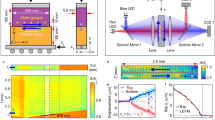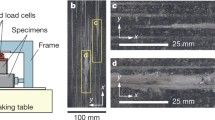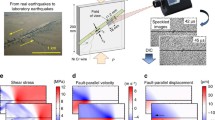Abstract
Although laboratory stick-slip friction experiments have long been regarded as analogs to natural crustal earthquakes, the potential use of laboratory results for understanding the earthquake source mechanism has not been fully exploited because of essential difficulties in relating seismographic data to measurements made in the controlled laboratory environment. Mining-induced earthquakes, however, provide a means of calibrating the seismic data in terms of laboratory results because, in contrast to natural earthquakes, the causative forces as well as the hypocentral conditions are known. A comparison of stick-slip friction events in a large granite sample with mining-induced earthquakes in South Africa and Canada indicates both similarities and differences between the two phenomena. The physics of unstable fault slip appears to be largely the same for both types of events. For example, both laboratory and mining-induced earthquakes have very low seismic efficiencies\(\eta = \tau _a /\bar \tau\) where τ a is the apparent stress and\(\bar \tau\) is the average stress acting on the fault plane to cause slip; nearly all of the energy released by faulting is consumed in overcoming friction. In more detail, the mining-induced earthquakes differ from the laboratory events in the behavior of η as a function of seismic momentM 0. Whereas for the laboratory events η≃0.06 independent ofM 0, η depends quite strongly onM 0 for each set of induced earthquakes, with 0.06 serving, apparently, as an upper bound. It seems most likely that this observed scaling difference is due to variations in slip distribution over the fault plane. In the laboratory, a stick-slip event entails homogeneous slip over a fault of fixed area. For each set of induced earthquakes, the fault area appears to be approximately fixed but the slip is inhomogeneous due presumably to barriers (zones of no slip) distributed over the fault plane; at constant\(\bar \tau\), larger events correspond to largerτ a as a consequence of fewer barriers to slip. If the inequality τ a /\(\bar \tau\) ≤ 0.06 has general validity, then measurements of τ a =µE a /M 0, where μ is the modulus of rigidity andE a is the seismically-radiated energy, can be used to infer the absolute level of deviatoric stress at the hypocenter.
Similar content being viewed by others
References
Abercrombie, R., andLeary, P. (1993),Source Parameters of Small Earthquakes Recorded at 2.5 km Depth, Cajon Pass, Southern California: Implications for Earthquake Scaling, Geophys. Res. Lett.20, 1511–1514.
Adams, J., Wetmiller, R. J., Hasegawa, H. S., andDrysdale, J. (1991),The First Surface Faulting from a Historical Intraplate Earthquake in North America, Nature352, 617–619.
Aki, K. (1966),Generation and Propagation of G Waves from the Niigata Earthquake of June 16, 1964, 2, Estimation of Earthquake Moment, Released Energy, and Stress-strain Drop from the G Wave Spectrum, Bull. Earthquake Res Inst. Tokyo Univ.44, 73–88.
Aki, K., andRichards, P. G.,Quantitative Seismology: Theory and Methods (Freeman, Cooper, San Francisco, CA 1980).
Boatwright, J. (1980),A Spectral Theory for Circular Seismic Sources; Simple Estimates of Source Dimension, Dynamic Stress Drop, and Radiated Seismic Energy, Bull. Seismol. Soc. Am.70, 1–27.
Brace, W. F., andByerlee, J. D. (1966),Stick Slip as a Mechanism for Earthquakes, Science153, 990–992.
Brummer, R. K., andRokke, A. J.,Case studies on large rockbursts in South African gold mines. InRockbursts and Seismicity in Mines (ed. Fairhurst, C.) (Balkema, Rotterdam 1990), pp. 323–329.
Brune, J. N. (1970),Tectonic Stress and the Spectra of Seismic Shear Waves from Earthquakes, J. Geophys. Res.75, 4997–5009. (Correction (1971), J. Geophys. Res.76, 5002.)
Brune, J. N.,The physics of earthquake strong motion. InSeismic Risk and Engineering Decisions (ed. Lomnitz, C., and Rosenbluth, E.) (Elsevier, New York 1976) pp. 141–177.
Churcher, J. M.,The effect of propagation path on the measurement of seismic parameters. InRockbursts and Seismicity in Mines (ed. Fairhurst, C.) (Balkema, Rotterdam 1990) pp. 205–209.
Cook, N. G. W.,The seismic location of rockbursts. InProc Fifth Rock Mechanics Symposium (Pergamon Press, Oxford 1963) pp. 493–516.
Cook, N. G. W., Hoek, E., Pretorius, J. P. G., Ortlepp, W. D., andSalamon, M. D. G. (1965),Rock Mechanics Applied to the Study of Rockbursts, J. S. Afr. Inst. Min. Metall.,66, 435–528.
Das, S., andAki, K. (1977),Fault Plane with Barriers: A Versatile Earthquake Model, J. Geophys. Res.82, 5658–5670.
Das, S. andKostrov, B. V. (1983),Breaking of a Single Asperity: Rupture Process and Seismic Radiation, J. Geophys. Res.88, 4277–4288.
Dieterich, J. H. (1979),Modelling of Rock Friction, 1. Experimental Results and Constitutive Equations, J. Geophys. Res.84, 2161–2168.
Dieterich, J. H. (1981),Potential for Geophysical Experiments in Large-scale Tests, Geophys. Res. Lett.8, 653–656.
Dieterich, J. H. (1992),Earthquake Nucleation on Faults with Rate-and State-dependent Strength, Tectonophysics211, 115–134.
Fletcher, J. B., Boatwright, J., Haar, L., Hanks, T., andMcGarr, A. (1984),Source Parameters for Aftershocks of the Oroville, California, Earthquake, Bull. Seismol. Soc. Am.74, 1101–1123.
Gay, N. C., andOrtlepp, W. D. (1979),Anatomy of a Mining-induced Fault Zone, Geol. Soc. Am. Bull.90, 47–58.
Gibowicz, S. J., Young, R. P., Talebi, S., andRawlence, D. J. (1991),Source Parameters of Microseismic Events at the Underground Research Laboratory in Manitoba, Canada: Scaling Relations for the Events with Moment Magnitude Smaller than — 2, Bull. Seismol. Soc. Am.,81, 1157–1182.
Hanks, T. C. (1977),Earthquake Stress Drops, Ambient Tectonic Stress and Stresses that Drive Plate Motions, Pure. Appl. Geophys.115, 441–458.
Hanks, T. C. (1992),Small Earthquakes, Tectonic Forces, Science256, 1430–1432.
Hanks, T. C., andWyss, M. (1972),The Use of Body Wave Spectra in the Determination of Seismic Source Parameters, Bull. Seismol. Soc. Am.62, 561–589.
Hanks, T. C., andKanamori, H. (1979),A Moment Magnitude Scale, J. Geophys. Res.,84, 2348–2350.
Heaton, T. H. (1990),Evidence for, and Implications of Self-healing Pulse of Slip in Earthquake Rupture, Phys. Earth Planet. Sci.16, 1–20.
Houston, H. (1990),A Comparison of Broadband Source Spectra, Seismic Energies, and Stress Drops of the 1989 Loma Prieta and 1988 Armenian Earthquakes, Geophys. Res. Lett.17, 1413–1416.
Kanamori, H., Hong-Kie, T., Dreger, D., andHauksson, E. (1992),Initial Investigation of the Landers, California, Earthquake of 28 June 1992 Using Terrascope, Geophys. Res. Lett.19, 2267–2270.
Keilis-Borok, V. I. (1959),On Estimation of the Displacement in an Earthquake Source and of Source Dimension, Ann. Geofis.12, 205–214.
Lachenbruch, A. H., andMcGarr, A. (1990),Stress and heat flow. U.S. Geological Survey Professional Paper1515, The San Andreas Fault System (ed. Wallace, R.) pp. 261–277.
Lockner, D. A., andOkubo, P. G. (1983),Measurements of Frictional Heating in Granite, J. Geophys. Res.88, 4313–4320.
Madariaga, R. (1976),Dynamics of an Expanding Circular Fault, Bull. Seismol. Soc. Am.66, 639–666.
Martin, C. D., andYoung, R. P.,The effect of excavation-induced seismicity on the strength of Lac du Bonnet granite. InRockbursts and Seismicity in Mines (ed. Young, R. P.) (Balkema, Rotterdam 1993) pp. 367–371.
McGarr, A. (1976),Seismic Moments and Volume Changes, J. Geophys. Res.81, 1487–1494.
McGarr, A. (1984),Scaling of Ground Motion Parameters, State of Stress, and Focal Depth, J. Geophys. Res.89, 6969–6979.
McGarr, A. (1991),Observations Constraining Near-source Ground Motion Estimated from Locally Recorded Seismograms, J. Geophys. Res.96, 16,495–16,508.
McGarr, A. (1992a),An Implosive Component in the Seismic Moment Tensor of a Mining-induced Tremor, Geophys. Res. Lett.19, 1579–1582.
McGarr, A. (1992b),Moment Tensors of Ten Witwatersrand Mine Tremors, Pure Appl. Geophys.139, 781–800.
McGarr, A.,Factors influencing the strong ground motion from mining-induced tremors. InRockbursts and Seismicity in Mines (ed. Young, R. P.) (Balkema, Rotterdam 1993) pp. 3–12.
McGarr, A., Spottiswoode, S. M., andGay, N. C. (1975),Relationship of Mine Tremors to Induced Stresses and to Rock Properties in the Focal Region, Bull. Seismol. Soc. Am.65, 981–993.
McGarr, A., andGay, N. C. (1978),State of Stress in the Earth's Crust, Ann. Rev. Earth Planet. Sci.6, 405–436.
McGarr, A., Spottiswoode, S. M., Gay, N. C., andOrtlepp, W. D. (1979),Observations Relevant to Seismic Driving Stress, Stress Drop, and Efficiency, J. Geophys. Res.84, 2251–2261.
McGarr, A., Bicknell, J., Sembera, E., andGreen, R. W. E. (1989),Analysis of Exceptionally Large Tremors in Two Gold Mining Districts of South Africa, Pure Appl. Geophys.129, 295–307.
Ortlepp, W. D. (1978),The—Mechanism of a Rockburst, Proc. of the 19th U.S. Rock Mechanics Symposium, University of Nevada, Reno, 476–483.
Savage, J. C., andWood, M. D. (1971),The Relationship Between Apparent Stress and Stress Drop. Bull. Seismol. Soc. Am.61, 1381–1388.
Scholz, C. H.,The Mechanics of Earthquakes and Faulting (Cambridge Univ. Press, Cambridge, U.K. 1990).
Sieh, K. E. et al. (1993),Near-field Investigations of the Landers Earthquake Sequence, April to July 1992, Science260, 171–176.
Spottiswoode, S. M. (1980),Source Mechanism Studies on Witwatersrand Seismic Events, Ph.D. Thesis, University of Witwatersrand, Johannesburg, South Africa.
Spottiswoode, S. M., andMcGarr, A. (1975),Source Parameters of Tremors in a Deep-level Gold Mine, Bull. Seismol. Soc. Am.65, 93–112.
Talebi, S., andYoung, R. P.,Failure mechanism of crack propagations induced by shaft excavation at the Underground Research Laboratory. InRock at Greath Depth 3 (eds. Maury, V., and Fourmaintraux, D.) (Balkema, Rotterdam 1990) pp. 1455–1461.
Urbancic, T. I., andYoung, R. P. (1993),Space-time Variations in Source Parameters of Mininginduced Seismic Events with M<0, Bull. Seismol. Soc. Am.83, 378–397.
Vassiliou, M. S. andKanamori, H. (1982),The Energy Release in Earthquakes, Bull. Seismol. Soc. Am.72, 371–387.
Vernik, L., andZoback, M. D.,Effects of rock elastic and strength properties in estimation of the state of stress at depth. InRock at Greath Depth 2 (eds. Maury, V., and Fourmaintraux, D.) (Balkema, Rotterdam 1990) pp. 1033–1040.
Walsh, J. B. (1971),Stiffness in Faulting and Friction Experiments J. Geophys. Res.,76, 8597–8598.
Wyss, M., andBrune, J. N. (1968),Seismic Moment, Stress, and Source Dimensions for Earthquakes in the California-Nevada Region, J. Geophys. Res.73, 4681–4694.
Young, R. P., Talebi, S., Hutchins, D. A., andUrbancic, T. I. (1989),Analysis of Mining-induced Microseismic Events at Strathcona Mine, Sudbury, Canada, Pure Appl. Geophys.129, 455–474.
Author information
Authors and Affiliations
Rights and permissions
About this article
Cite this article
McGarr, A. Some comparisons between mining-induced and laboratory earthquakes. PAGEOPH 142, 467–489 (1994). https://doi.org/10.1007/BF00876051
Received:
Revised:
Accepted:
Issue Date:
DOI: https://doi.org/10.1007/BF00876051




